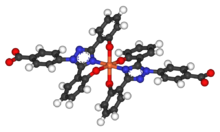This is an old revision of this page, as edited by Beetstra (talk | contribs) at 13:37, 15 November 2011 (Script assisted update of identifiers for the Chem/Drugbox validation project (updated: 'ChEMBL').). The present address (URL) is a permanent link to this revision, which may differ significantly from the current revision.
Revision as of 13:37, 15 November 2011 by Beetstra (talk | contribs) (Script assisted update of identifiers for the Chem/Drugbox validation project (updated: 'ChEMBL').)(diff) ← Previous revision | Latest revision (diff) | Newer revision → (diff) Pharmaceutical compound | |
| Clinical data | |
|---|---|
| License data |
|
| Pregnancy category |
|
| Routes of administration | Oral |
| ATC code | |
| Legal status | |
| Legal status | |
| Pharmacokinetic data | |
| Bioavailability | 70% |
| Protein binding | 99% |
| Metabolism | Hepatic glucuronidation |
| Elimination half-life | 8 to 16 hours |
| Excretion | Fecal (84%) and renal (8%) |
| Identifiers | |
IUPAC name
| |
| CAS Number | |
| PubChem CID | |
| DrugBank | |
| ChemSpider | |
| UNII | |
| KEGG | |
| CompTox Dashboard (EPA) | |
| ECHA InfoCard | 100.211.077 |
| Chemical and physical data | |
| Formula | C21H15N3O4 |
| Molar mass | 373.362 g/mol g·mol |
| 3D model (JSmol) | |
SMILES
| |
InChI
| |
| (what is this?) (verify) | |
Deferasirox (marketed as Exjade) is a rationally-designed oral iron chelator. Its main use is to reduce chronic iron overload in patients who are receiving long-term blood transfusions for conditions such as beta-thalassemia and other chronic anemias. It is the first oral medication approved in the USA for this purpose.
It was approved by the United States Food and Drug Administration (FDA) in November 2005. According to FDA (May 2007), renal failure and cytopenias have been reported in patients receiving deferasirox oral suspension tablets.
Properties of deferasirox

The half-life of deferasirox is between 8 and 16 hours allowing once a day dosing. Two molecules of deferasirox are capable of binding to 1 atom of iron which are subsequently eliminated by fecal excretion. Its low molecular weight and high lipophilicity allows the drug to be taken orally unlike desferoxamine which has to be administered by IV route (intravenous infusion). Together with deferiprone, deferasirox seems to be capable of removing iron from cells (cardiac myocytes and hepatocytes) as well as removing iron from the blood.
Synthesis
Deferasirox can be prepared from simple commercially available starting materials (salicylic acid, salicylamide and 4-hydrazinobenzoic acid) in the following two-step synthetic sequence:

The condensation of salicyloyl chloride (formed in situ from salicylic acid and thionyl chloride) with salicylamide under dehydrating reaction conditions results in formation of 2-(2-hydroxyphenyl)-1,3(4H)-benzoxazin-4-one. This intermediate is isolated and reacted with 4-hydrazinobenzoic acid in the presence of base to give 4-(3,5-bis(2-hydroxyphenyl)-1,2,4-triazol-1-yl)benzoic acid (Deferasirox).
Risks
Deferasirox was the #2 drug on the list of 'Most frequent suspected drugs in reported patient deaths' compiled by the Institute for Safe Medical Practices in 2009. There were 1320 deaths reported, perhaps explained by an update to the ADE data of Novartis, and a new boxed warning about gastrointestinal haemorrhage as well as kidney and liver failure.
References
- "FDA-sourced list of all drugs with black box warnings (Use Download Full Results and View Query links.)". nctr-crs.fda.gov. FDA. Retrieved 22 Oct 2023.
- ^ Choudhry VP, Naithani R (2007). "Current status of iron overload and chelation with deferasirox". Indian J Pediatr. 74 (8): 759–64. doi:10.1007/s12098-007-0134-7. PMID 17785900. Free full text
- Yang LP, Keam SJ, Keating GM (2007). "Deferasirox : a review of its use in the management of transfusional chronic iron overload". Drugs. 67 (15): 2211–30. PMID 17927285.
{{cite journal}}: CS1 maint: multiple names: authors list (link) - ^ "FDA Approves First Oral Drug for Chronic Iron Overload" (Press release). United States Food and Drug Administration. November 9, 2005. Retrieved 2007-10-31.
- Stefan Steinhauser, Uwe Heinz, Mark Bartholomä, Thomas Weyhermüller, Hanspeter Nick, Kaspar Hegetschweiler (2004). "Complex Formation of ICL670 and Related Ligands with Fe and Fe". European Journal of Inorganic Chemistry. 2004 (21): 4177–4192. doi:10.1002/ejic.200400363.
{{cite journal}}: CS1 maint: multiple names: authors list (link)] - ISMP (2010). "ISMP QuarterWatch(TM)". Vol. 15, no. 12. ISMP Medication Safety Alert. pp. 1–3.
| Chelating agents / chelation therapy (V03AC, others) | |
|---|---|
| Copper | |
| Iron | |
| Lead | |
| Thallium | |
| Other | |
| |